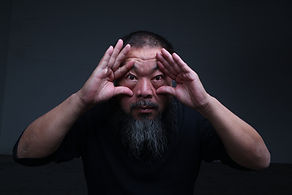“Nothing is true, everything is permitted” is a motto handed down from the Order of the Assassins and the Crusaders. The motto points to a crisis of macro-narrative structures and the contrived nature of established norms.In a given reality, nihilist arguments could be used as mottos for artists, in that artists construct grand narrative landscapes and announce that they will not explain them. These massive efforts are all for a period of indescribable immersive experience.
Weare still delighted to immerse ourselves in thesegrand contrivances, as they are the reasons for every action within the industry. The flashiness of culture cannot cover the incisiveness of artists.Through this nihilistic assassin’s creed, the artists in this exhibition, Huang Yong Ping, Zhao Zhao, Sun Yuan, Ai Weiwei, and Zhu Jia, have achieved a common understanding.
Nietzsche explained this maxim as:“Nothing is true, all is permitted. Like a hero of Dostoyevsky, governed by your nihilistic gods, you would destroy me without hesitation, as if it were a pure sacred act.”
AI WEIWEI
b.1957 Beijing, China
Ai Weiwei is a Chinese Contemporary artist and activist. Ai collaborated with Swiss architects Herzog & de Meuron as the artistic consultant on the Beijing National Stadium for the 2008 Olympics. As a political activist, he has been highly and openly critical of the Chinese Government's stance on democracy and human rights. He has investigated government corruption and cover-ups, in particular the Sichuan schools corruption scandal following the collapse of so-called "tofu-dreg schools" in the 2008 Sichuan earthquake. In 2011, following his arrest at Beijing Capital International Airport on 3 April, he was held for 81 days without any official charges being filed; officials alluded to their allegations of "economic crimes".

 黄永砯 HUANG Yongping塔 Towers 树脂,硅胶,钢材Resin, Silicon, Concrete, Steel 1100 x 50 x 50 cm x 4 pics 2014 |  赵赵 ZHAO Zhao迷津Confusion 铜板Copper plates 200 x 100cm x 9 件 彩色微喷照片Giclee 30 x 18 cm x 2 件 纸本水墨 Ink on paper 28 x 19 cm x 9 件 2015 |  朱加ZHU JiaIt’s Beyond my control 影像装置 Video Installation 5 mins (4 editions +2AP) 2013 |
|---|---|---|
 孙原 SUN Yuan嘚逼嘚blahblahblah 材料可变,尺寸可变,原理不变 Variable material variable size Invariable theory 3 editions+1 AP 2017 |  艾未未 Ai weiwei着色树根 Colored Root 钢铁,汽车漆 Cast iron with auto paint 160 x 125 x 73 cm 2015 |  赵赵 ZHAO Zhao天空 Sky 布面油画 Oil on canvas 400 x 400 cm 2016 |
HUANG YONGPING
b.1954 Xiamen, China
Huang was one of the first artists to consider that art was a strategy. He was a self-taught student educating himself under three well-known men. Joseph Beuys well known German artist and art theorist, John Cage an American music theorist and philosopher, and Marcel Duchamp a French artist that's associated with Dadaist and Surrealist. He then graduated in 1982 from CAFA in Hangzhoue. In 1986 he formed Xiamen Dada. Huang Yong Ping has four periods associated with himself, anti-artistic affectation (fan jiaoshi zhuyi), anti-self-expression (fan ziwo biaoxian he xingshi zhuyi), anti-art (fan yishu), and anti-history (fanyishushi). In 1989 at the age of 35 Huang Yong Ping went to Paris for the Magiciens de la terre exhibit. He then ended up immigrating to France and living there ever since. Many of his pieces today are on a large scale, making them not auction-compatible.
Huang Yong Ping represented France at the 1999 Venice Biennale. In 2016 his 'Empires' was the selection for the biennial Monumenta exposition at the Grand Palais in Paris.

SUN YUAN & PENG YU
b. 1972 Beijing, China
Sun Yuan graduated from the Fourth Studio, Department of Oil Painting, Central Academy of Fine Arts; Peng Yu was born in Heilongjiang Province, China in 1974 and graduated from the Third Studio, Department of Oil Painting, Central Academy of Fine Arts in 1998. Currently they both work and live in Beijing. The pair has been collaborating ever since 2000 and are renowned for their controversial installations and conceptual works. They won the 2001 Chinese Contemporary Art Awards (CCAA) and took part in the 51st Venice Biennial as representatives of China, known for working with extreme materials such as human fat tissue, animal specimens and even baby cadavers.

ZHU JIA
b. 1963 Beijing, China
A former painter who is now one of China’s most influential video artists, Zhu Jia creates cinematic works in which he reflects on the transformation of China through plotless, a-logical streams of images. He places himself in the category of conceptual artists because, as he says, expression “is about what you do with your mind”. In Waltz (2013), a couple dance, separate, come together, and dance again. The settings and their clothing—first Mao suits, then stylish outfits reminiscent of 1930s Shanghai—suggest time is running backwards. When the camera moves back to reveal the set, time leaps forward but our sense of the film’s reality is overturned.

Zhao Zhao
Born 1982 Xinjiang, China
Zhao Zhao graduated from the Xinjiang Institute of the Arts in 2003 and later attended the Beijing Film Academy. The former assistant to Ai Weiwei and now regarded a significant figure among the young Post-80s generation of contemporary Chinese artists – Zhao Zhao’s work is often associated with anti-authoritarian or non-conformist tendencies, renowned for confronting existing ideological structures and exercising the power of individual free will in his work. His provocative, multidisciplinary artistic practice has garnered him international attention in recent years with critically-acclaimed exhibitions across China, North America and Europe as an ‘artist to watch’.

Inquire about this exhibition



